Understanding the Verizon iPhone 4 Announcement
by Anand Lal Shimpi on January 11, 2011 1:32 PM EST- Posted in
- Smartphones
- Apple
- iPhone 4
- Verizon
- Mobile
Earlier today Verizon did what has been rumored for a while now and announced a partnership with Apple beginning with the CDMA iPhone 4.
Device pricing remains unchanged from the AT&T iPhone 4. The 16GB model retails for $199.99 while the 32GB will set you back $299.99. There is no white version available.
Hardware specs, both internal and external, remain unchanged. Apple is also quoting the same battery life as the AT&T version of the iPhone 4, although battery life is very dependent on signal strength so it will vary depending on network coverage where you use the phone.
Verizon isn't talking about data plan pricing and specifics at this point, although I suspect we'll find that out closer to the February 10th release date. Existing Verizon customers will be able to pre-order online beginning February 3rd, while the floodgates will open for everyone else on the 10th. Verizon insists that it has prepared both its retail presence and network for the launch, what that means for availability and likelihood of you getting a device remains to be seen. The good news is the iPhone 4 is a mature device that shouldn't be production limited. The launch will mostly be a question of whether Apple/Verizon appropriately estimated the number of customers they'll have on day 1.
Gallery: The Verizon iPhone 4
Verizon will offer a personal hotspot option for its iPhone 4, a feature that isn't available on AT&T. Apple wouldn't say if there are other architectural changes required for it, There aren't any architectural changes to enable personal hotspot, it's just something that Verizon supports and AT&T doesn't. Verizon isn't talking about pricing for enabling personal hotspot but functionally it works very similarly to tethering on the AT&T iPhone. You enable personal hotspot which you can use over Bluetooth or USB. If you have WiFi enabled you can connect up to 5 devices via WiFi to the Verizon iPhone 4.
Receive Antenna Diversity - The New Strip
I've got some more detail on the difference in antenna design on this new iPhone. As you can see from the pictures below, the good ol' death grip still attenuates signal strength on Verizon. Held normally I was getting a reading of -65 dBm on the Verizon iPhone, but in full on death grip the signal strength dropped to -83 dBm. That's in line with what we've seen on AT&T.
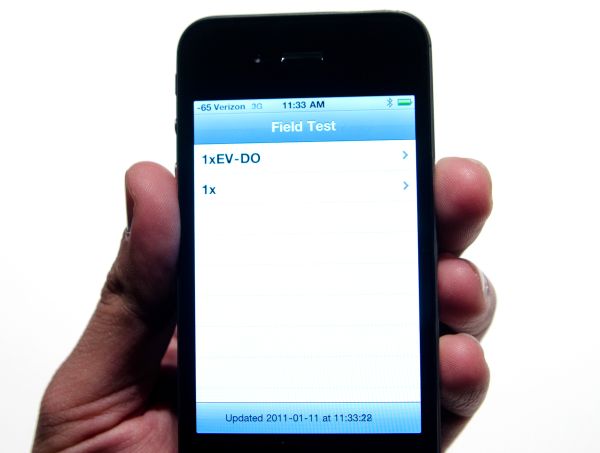
Verizon iPhone 4 - Held "properly"
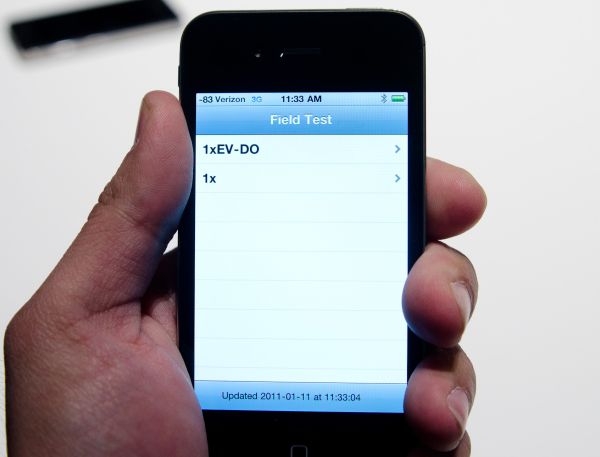
Verizon iPhone 4 - "Deathgrip"
You will notice that there are more external antenna segments on the Verizon iPhone compared to the AT&T model. Specifically, there's a new strip at the very top of the phone that previously was a part of the UMTS/GSM antenna. With the Verizon iPhone 4 that strip is actually for a secondary receive antenna. This dual-receive antenna architecture is something that Verizon refers to as antenna diversity and it's a part of Verizon's spec for devices on its network. This is not something that's present on the GSM version of the iPhone 4.
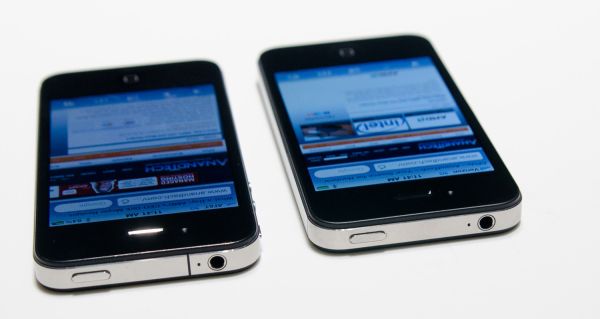
AT&T iPhone 4 (left) vs. Verizon iPhone 4 (right) - Note the new antenna segment on the top
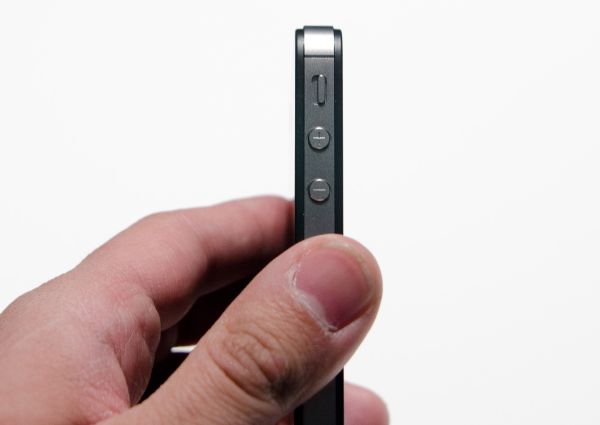
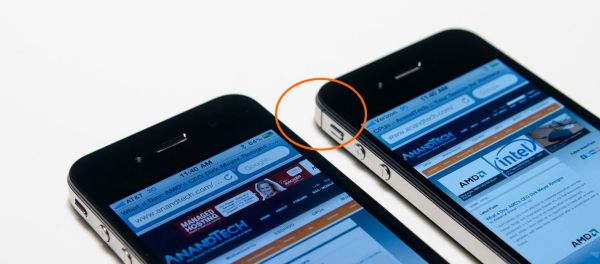
AT&T iPhone 4 (left) vs. Verizon iPhone 4 (right) - Note the new strip, that separates the secondary receive antenna
It's too early to tell if receive antenna diversity will mitigate the hand holding problems that drop calls in low signal scenarios. We will have to do extensive testing before we can figure that part out.
Network Performance
As far as network performance goes, AT&T's signal is strong but performance isn't very good at the Lincoln Center where Verizon held today's press event. To showcase network performance we have a couple of options. First up is a web page load test. I loaded three pages: AnandTech.com, our Dirk Meyer article and the CPU section on the site. The video below shows the latter two in action (AT&T on the left, Verizon on the right):
Again I have to mention that AT&T's performance at the Lincoln Center in NYC is pretty bad, definitely worse than it is at my office in Raleigh, NC. This is ultimately what will determine whether you go with the Verizon or AT&T versions of the iPhone 4 - what the network coverage looks like in your area.
Apple didn't have any installations of the Speedtest app, so we had to resort to using testmy.net. I ran three times on both the upload and download, I've reported the results below:
| Verizon iPhone 4 Network Performance at Lincoln Center in NYC | ||||
| Direction | Downstream | Upstream | ||
| Average | 1888 kbps | 321 kbps | ||
| Max/Min | 2238/1483 kbps | 368/256 kbps | ||
Download speed is suspiciously good. At 2.2Mbps it's higher than I have seen AT&T's iPhone 4 hit anywhere in NYC and the highest download speed I've ever seen for a device on Verizon that I've tested. Verizon likely has a local femtocell here to guarantee the best performance possible.
Upload speed is significantly worse however at only 321Kb/s on average. This is pretty typical for EVDO devices.
We'll have to wait until we get devices in hand before we can truly characterize network performance on the new Verizon iPhone 4. The numbers above are only a small snapshot of behavior.
As I mentioned in our earlier coverage, you can't use data and voice at the same time on the Verizon iPhone 4 (unless the data is over WiFi). If you are in the middle of a call and try to load a web page you'll get an error telling you that data is not available.
You'll notice that the 3G marker goes away during a call as well (because the call doesn't technically use the 3G radio). It doesn't disappear when you're sending an SMS however.
And there you have it. We'll be publishing a full review as soon as we can get our hands on a sample.


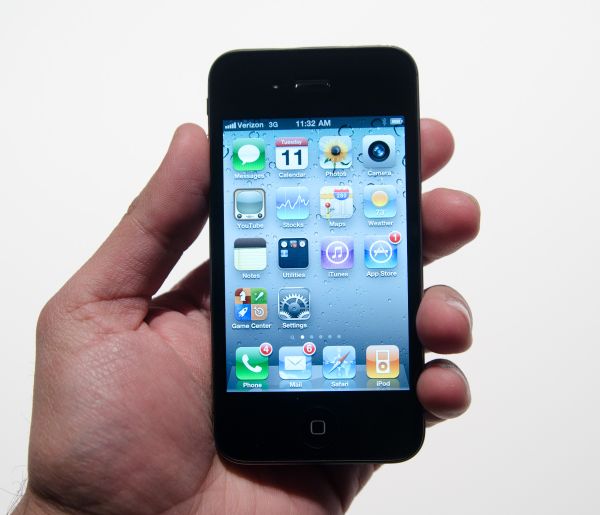






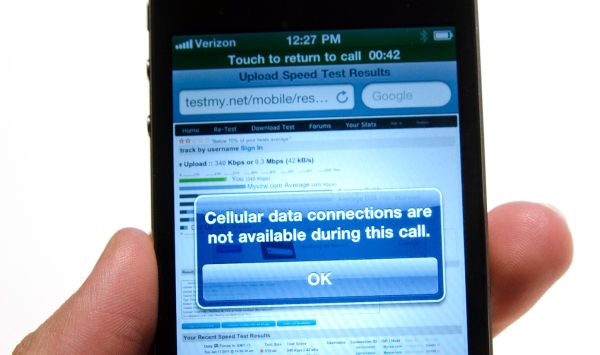








63 Comments
View All Comments
anactoraaron - Wednesday, January 12, 2011 - link
to spend $$ for the ETF and then buy the EXACT SAME PHONE you have with at&t and then be cornered with another 2 year service contract with overpriced data plan that actually will be half the speed on average than AT&T. Wonder when Verizon's data and reception issues overtake at&t's.The so called "analysts" say Apple will sell like 11 million iPhones on verizon. Really? I don't think that's even in the ballpark. 2 million maybe... maybe. Verizon customers have had android devices and AT&T has had the iPhone. If someone really wanted the iPhone, they would already have it (and judging by the lines for the iPhone 4 release this would be correct). Everyone who really wanted Verizon has given android devices a shot and most people love them (enough to not want an iPhone).
I predict Verizon iPhone 4 being an epic fail.
anactoraaron - Wednesday, January 12, 2011 - link
...I realize all data plans are priced the same, but that doesn't mean that they aren't overpriced to begin with.michael2k - Wednesday, January 12, 2011 - link
There's this thing called "saturation"?If you look at the last 6 quarters you will see AT&T activated like 21m iPhones out of 30m smartphones. Estimates are that 16m of those iPhones are active (some are replacements and hand me downs).
If you look at the last 6 quarters on Verizon, you see only about 10m Android phones sold, with the limit being Android only being available for 5 quarters.
So the crux is that Verizon has 93m subscribers and AT&T has 92m subscribers. Only "half" as many Android phones have sold as iPhones, meaning a large number of potential smartphone buyers on Verizon (about 11m) haven't bought in yet.
Hmm, 11m, you say? So yeah, that's a good estimate of how many iPhones might be sold on Verizon.
strikeback03 - Wednesday, January 12, 2011 - link
I suppose that puts an upper limit on the number, but I doubt it will hit that anytime soon. Seems there are 3 groups of consumers involved:1) Current Verizon smartphone customers. Obviously don't mind paying for data. Includes some people who wanted an iPhone but couldn't deal with AT&T. Also includes some on BB/WM who didn't want to pay to upgrade to Android early, but will likely choose between Android and iPhone. A substantial portion of iphone buyers will probably come from this group.
2) Current Verizon non-smartphone customers, a lot of your 11m number. Some may go for an iPhone, but the cost of the data plans will keep a lot in featurephones, while others are probably more likely to go for the free Android phones. Will probably see some iPhone customers come from this group, but I think a lot are still in featurephones because they don't need/want the cost of smartphones.
3) non-Verizon customers. Some portion of AT&T iPhone customers will likely jump ship when their contract is up, and some people who couldn't stand AT&T will probably jump as well.
IMO, there will be a lot of iphones sold on Verizon, though not necessarily iphone 4s. For example I doubt many AT&T users would buy a verizon iphone 4 if they already had an AT&T one, but a lot might make the switch to the iphone 5.
gozoogle - Wednesday, January 26, 2011 - link
I'm in group 2, and I know a lot of other people. Most of us really want the iPhone and not Android, but aren't willing to switch to AT&T. I think group 2 will make up the majority of people buying next month.NCM - Wednesday, January 12, 2011 - link
anactoraaron writes: "I predict Verizon iPhone 4 being an epic fail."Mind if we all make note of that for some mild future amusement at your expense?
There's a colossal pent-up demand for a VZ iPhone, from the people who live in AT&T no-go zones, those who already have VZ service ties such as family plans and in-network free calling, others who just don't like AT&T for various reasons, and so on. VZ has 93 million subscribers who mostly chose to be there. There's no reason to suppose that several million of them won't be interested in the iPhone, just as they have been on other carriers in many other countries.
I predict VZ will sell boatloads of them. And feel free to make a note of that.
As immature and disappointing as the initial version is in many respects, I find WP7 to be much more interesting than Android. MS has actually come up with compelling interface paradigms that offer something genuinely different and interesting. Who would ever have imagined that? I'm not sure their boat hasn't already sailed, but it's always risky to count MS out of the game.
TareX - Wednesday, January 12, 2011 - link
Please note that VZN users will choose between a LTE 4.3" Bionic, with Terga 2.... or a 800 Mhz iPhone 4.... on 3G.It'll be a tough choice.
NCM - Wednesday, January 12, 2011 - link
TareX writes: "Please note that VZN users will choose between a LTE 4.3" Bionic, with Terga 2.... or a 800 Mhz iPhone 4.... on 3G."The recently announced Droid Bionic won't be available until Q2 2011 sometime, and other than some brief CES hands-on impressions nobody knows how it performs overall. (I'd certainly imagine it to be fast though.) In particular it'll be interesting to see whether the dismal battery life of the (few) other 4G phones has been improved or not.
Furthermore most cell phone users won't have 4G data networks available to them anytime soon. VZ has one site in my state of Indiana and no plans for more in 2011. <Insert your own joke here about Indiana not being the centre of the known tech universe.>
The thing to remember is that Tegra 2 or 800 MHz means something to those of us who read AT, but nothing whatsoever to the average smartphone buyer. Despite occasional missteps, Apple has proven itself to be the master of the quality user experience. Don't underestimate the appeal.
anactoraaron - Thursday, January 13, 2011 - link
you may be right on there. I would like to think with the SoC shrink and moore's law there will be basically a trade off on battery life using 4G. But even so, with the limited availability of 4G one can imagine it's not too hard to disable the 4G radio. Battery life on the Tegra 2 is supposed to be on better than current gen SoC's.But that magical Apple iPhone appeal is there. And it's true that the average person doesn't know/care about the processor, etc inside the phone.
Funny how I was born in Indiana. We got everything last LOL- especially fashion!
gozoogle - Wednesday, January 26, 2011 - link
Another example of why product design groups led by engineers fail.For your average consumer (i.e. not male geeks):
LTE without good battery life, FAIL
bulky 4.3" screen with low dpi, FAIL
If you don't understand what your mainstream customers value in the product and design according to bigger and better specs, FAIL